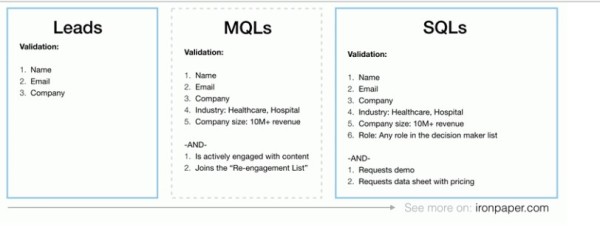
Too many companies keep their marketing and sales separated into two teams. They don’t connect with each other nor do they have access to each other’s data. This silo mentality results in a huge lost opportunity for these businesses — upwards of 10% or more revenue annually, according to IDC as compiled by HubSpot. The curated research also reveals:
- Companies that align their sales and more practices in place generated 208% more revenue from marketing efforts (Marketing Profs).
- Companies with dynamic, adaptable sales and marketing processes report an average 10% more of their salespeople meet their quotas compared to other companies (CSO Insights).
If your company wants to see similar benefits from a sales and marketing alignment, it’s time to restructure the two teams to facilitate better workflow between them.
3 Ways Content Can Build a Bridge Between Marketing and Sales
1. Share all data
Don’t ever let one team gather data that the other team can’t access. Sure, some marketing data is irrelevant to sales, but more often than not, it’s not. Don’t put parameters on what either team will share and that includes ensuring marketers access to the CRM. Universal access will lead to better communication and deeper insights, and will prevent duplicate work.
Universal access to sales & marketing data will lead to better communication & deeper insight. @xaltd Click To Tweet4 Ways to Use Data to Better Understand Your Content Production Process
2. Have unified buyer personas
Analytics and data must be shared across both teams. Using these insights enable more accurate, uniform buyer personas to be developed. In turn, the sales team is more adept at connecting with the target audience. The marketing team is better informed as to who it wants to read or view its content.
3. Define life-cycle movement
A whopping 68% of B2B marketers haven’t identified their marketing-sales funnel. If there is no customer journey process, how can you improve it? Both the marketing and sales teams should have a clear understanding of not only definitions but also of how a lead is pushed down the funnel to become a client. Both teams should have a clear vision of how this works.
68% of B2B marketers haven’t defined their marketing-sales funnel says @marketingsherpa via @xaltd. Click To Tweet4. Agree on qualifying criteria
Marketers should know what qualifies someone as a lead, a marketing-qualified lead (MQL), and a sales-qualified lead (SQL). If the two teams are not defining these terms in the same way, the leads are more likely to be scored incorrectly, resulting in a lot of missed opportunities for the business and improper crediting of leads within the company.

5. Create content based on the funnel
Up to 70% of marketing content goes unused. Why? It isn’t aligned with the interests of the target audience often because marketers ignore or are unaware of the sales funnel. The sales team isn’t going to use irrelevant content (and neither are the target buyers). The sales team should make its content needs clear through a detailed sales funnel as well as direct outreach to marketing. Marketers then can create content to inform, inspire, and educate leads, pushing them down the sales funnel.
The sales team should make its #content needs clear to marketing through a detailed sales funnel says @xaltd. Click To Tweet6. Use progressive profiling
Sales teams ignore 80% of marketing leads, which means the time and resources to earn those leads is wasted. If marketers offer better quality leads by improving the vetting process, the sales team can take these leads more seriously. Progressive profiling uses automation to gather intel on prospective clients, leading to better conversion rates. Together, sales and marketing can use this technique to produce more qualified leads.
Sales should explain why leads are not a fit so that marketers can adapt says @xaltd. Click To Tweet7. Use relevant content in emails and drip campaigns
At times, the sales team will write copy for an email marketing campaign without consulting the marketing team. Plus, 75% of buyers want content that curbs the sales-speak. Given that marketers know how to write copy that can attract clicks and engagement without sounding overly salesy, the sales team should take advantage of this internal resource. If the sales and marketing teams work together to craft the campaigns, the recipients are more likely to be interested.
8. Automate processes
Many sales and marketing processes can be automated which frees team members to work on higher-level tasks. Unfortunately, many employees do not fully understand how to use these technologies. Sales and marketing teams should be fully trained (and retrained, if necessary) to use the available technology properly and efficiently.
9. Don’t just say ‘the leads are bad’
For marketers honing their lead-generation practices, it’s not enough for salespeople to simply label a lead as “bad.” Sales should explain why leads are not a fit so that marketers adapt what they are doing to help produce better qualified leads.
10. Recycle sales leads to marketing
If a lead isn’t ready to buy, it should go back to the marketing team for more nurturing. Remember, 95% of buyers end up choosing a solution provider that “provided them with ample content to help navigate through each stage of the buying process.” So if a lead isn’t quite ready to pull the trigger, maybe valuable content will help them along the sales funnel.
In addition, even if the former sales lead isn’t going down the sales funnel today, that doesn’t mean marketing shouldn’t continue to nurture this contact. At a later date, this former prospect may be ready to buy and it’s invaluable to have your company on its radar.
Conclusion
The benefits are astounding when sales and marketing teams are aligned — they are 67% better at closing deals. Plus, almost 90% of teams that do sync sales and marketing report measurable increases in lead conversion. While it might not be a smooth road to alignment, it’s clear that when these two teams work together, much more can be accomplished.
Want to help your sales team learn more about how to use content marketing to improve their sales? Encourage them to subscribe to the CMI daily newsletter.
Cover image by Helloquence via pixabay.com

